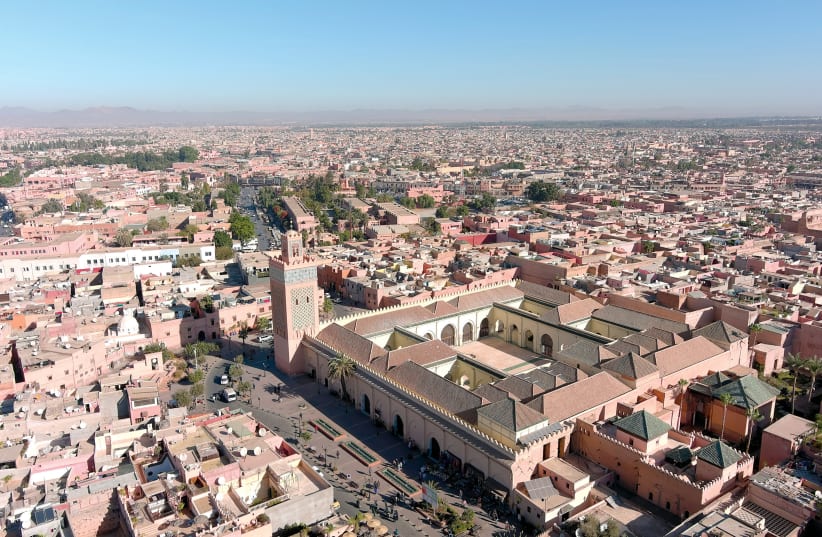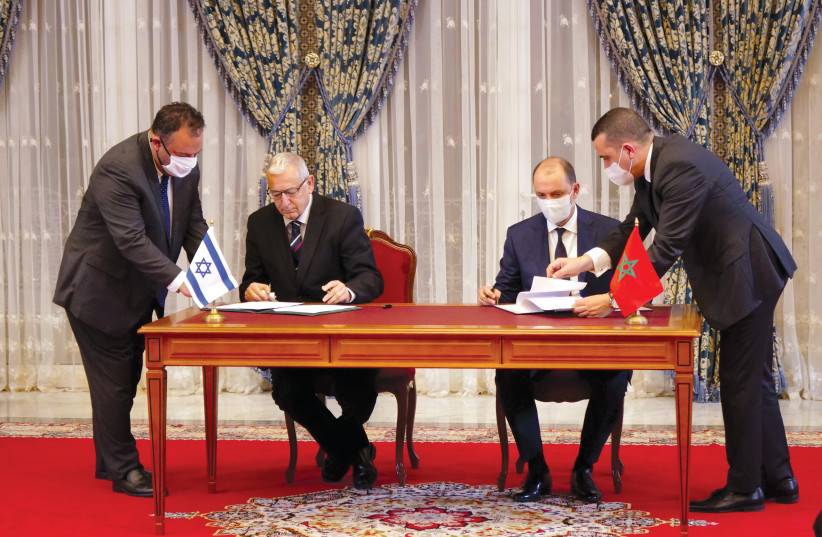The virginal expanses of the Sahara Desert; biblical-style mud-brick villages; snowy mountain ranges with Alpine-like ski resorts; bustling Oriental bazaars; elegant cities boasting French colonial style architecture, wide boulevards and parks; and renovated synagogues, along with a rich Jewish heritage. Welcome to Morocco, the country of contrasts and the latest go-to destination for Israeli tourists.
Morocco agreed to normalize relations with Israel in December 2020 within the framework of the US-brokered Abraham Accords, marking another key step ending Israel’s regional isolation. However, unlike the United Arab Emirates and Bahrain, which never had ties with Israel, Morocco has maintained informal bilateral ties since establishing low-level diplomatic relations during the 1990s.
During that period some Israelis traveled to Morocco via third countries, but tourism has surged since the introduction of direct flights after normalization. The 2022 figure of 200,000 Israelis visiting Morocco is set to increase this year. The country, understandably, is a favorite for Israelis of Moroccan origin.
A look inside Morocco
Morocco is officially a constitutional monarchy, but the king retains strong authoritarian power over the state and public affairs, despite some political reforms in recent decades. Images of Mohamed VI are everywhere, and the ruling family maintain more than 30 luxurious palaces across the country, which are closed to the public and heavily guarded. The current ruler – in contrast to some of his predecessors – is popular among the public. Contemporary Morocco is relatively liberal and secular and avoided the worst of the upheavals that spread across much of the Arab world during the Arab Spring.
The Atlas Mountains stretch across the country, dividing the northern Mediterranean and Atlantic coastlines from the arid Sahara Desert in the south. The mountains, dotted by Berber villages, offer breathtaking views and snow in the winter months.
A jeep excursion into the Sahara with the obligatory camel trek is a must for tourists. Most opt for the 20-minute introduction ride, but there are more challenging options for the adventurous.
Marrakesh, the center of the Hippie Trial in the 1960s, remains a top attraction for visitors. The main Jemma el-Fna Square is full of snake charmers, noisy musicians, street entertainers and henna artists. It leads into the main medina old city and the souk market, where you can find everything under the sun in the winding alleyways, from leather goods and Oriental rugs to silverware and crockery.
The pattern of the medina with the former Jewish Quarter, known as the Mellah, was repeated in most of the Moroccan cities we visited.
Fez, northwest of Marrakesh, is Morocco’s religious and cultural capital. The Chouara tannery, located in the heart of Fez’s medina, has been operating since the 12th century. Dozens of round stone vessels are filled with liquid for softening hides of camels, sheep, cows and goats. The hides are then submerged in natural dyes in a process that takes a few months before the leather is turned into clothing, shoes or other goods for sale. The stench is unbearable, particularly in the summer months; tourists are presented with sprigs of mint to hold to their nose.
Casablanca, on the Atlantic coast, is known to many from the 1942 film starring Humphrey Bogart and Ingrid Bergman, even though the entire movie was filmed in Hollywood. The port city reminds most Israelis of Haifa; it is Morocco’s largest city and its economic and business center.
Casablanca’s Hassan II Mosque is the largest mosque in Africa and one of the biggest in the world. It is a quintessential example of Moroccan Islamic architecture, with stunning marble columns, wooden ceilings and Italian chandeliers. It can accommodate more than 100,000 worshipers – most in the vast adjoining plaza. It even boasts a retractable roof.
Other key cities include the coastal port of Tangier, opposite Gibraltar at the southern tip of Spain, where the Mediterranean meets the Atlantic; and Rabat, Morocco’s capital, with a laid-back vibe and clean, elegant avenues.
The mountain village of Chefchaouen is known as the blue pearl of Morocco due to its numerous buildings painted blue. According to the urban myth, it was the Jewish residents of the village after fleeing Nazi-occupied Europe who started the tradition to connect the village to the heavens; but according to the local guide, it was just a gimmick thought up more recently to attract the tourists. In any event, it worked. The village is beautiful and is now firmly established on the tourist trail.
The traditional couscous and tajine dishes served everywhere are familiar to Israelis, along with the sweet deserts and cookies.
Morocco is large and requires at least 10 days and a lot of traveling to take in all the major sites. But it’s worth it. Enjoy! ■
Morocco’s Jews
At its peak, the Jewish community of Morocco numbered more than 250,000 – by far the largest across the Middle East. Today only a couple of thousand, mainly elderly, remain.
The ancient community from Roman times was boosted by the Jews who were expelled from Spain, and later Portugal, following the 1492 Alhambra Decree signed by Ferdinand and Isabella.
The status of the Jews in Morocco largely depended on who was in power; but despite some instances of antisemitism, for the most part the community was tolerated under the patronage of the royal family and allowed to flourish. Thriving communities developed a rich cultural heritage and renowned centers of Jewish learning.
Rabbi Moses Maimonides, the Rambam, one of the most influential Torah scholars in the Middle Ages, lived in Fez from 1159 to 1165, having fled from Cordoba in Spain to escape persecution.
It was in Fez that Maimonides, as well as serving as a physician to the sultan, wrote one of his most famous works, his Commentary on the Mishnah Oral Law.
The Jewish community was far from homogeneous. The communities in the coastal cities were French-speaking and more prosperous. Those from villages in the Atlas Mountains were similar to the Jews from Yemen.
Between 1948 and the 1970s, almost the entire community made aliyah, boosted by the end of French colonial rule in 1955, sometimes openly but often in a clandestine fashion in a massive operation coordinated by Mossad agents on the ground.
Today, Israeli and Jewish tourists are warmly welcomed. The Moroccan authorities have invested significant amounts of money, together with international Jewish donors, to restore synagogues and Jewish cemeteries across the country.
Almost every group of Israeli tourists has at least one member seeking to trace a former family home in the Jewish quarters of Fez, Casablanca, Rabat or Marrakesh or the grave of a deceased relative.
The vast majority of Jews of Moroccan descent now live in Israel, where they constitute the second-largest Jewish community, approximately half a million strong.
The initial absorption process was often traumatic with difficult conditions in the ma’abara makeshift camps or in the development towns set up in the periphery. But the second and third generation are now well established. Former foreign minister David Levy and former Labor party leader Amir Peretz are just two of the prominent Moroccan-Israelis who became household names.
The author traveled to Morocco in March as part of a group organized by the Jerusalem Journalists Association.

